
An Air Force T-38 Talon trainer jet in 2019 at Travis Air Force Base, Calif. (Heide Couch/Air Force)
WASHINGTON – The Air Force will miss its fiscal 2023 training goal by about 120 pilots, the service said.
The service will pin new wings on 1,350 airmen instead of its goal of 1,470. The Air Force’s goal for fiscal 2024 is 1,500, Air Force spokesman Benjamin Faske wrote in an email.
He said the Air Force in the last decade has produced on average about 1,300 pilots yearly, but various factors contribute to pilot training numbers.
“FY22 pilot training production was 1,276, down from 1,381 in FY21 due to continued challenges with civilian simulator instructor manning levels, T-6 supply shortfalls and T-38 engine overhaul delays,” Faske said.
Slower-than-expected repairs to the engines used on the T-38 Talon jets have limited the number of aircraft for more than a year that can be used for daily training missions. T-38s are the Air Force’s sole intermediate aircraft for teaching airmen to fly fighters and bombers.
“It has not gotten worse, but it has also not gotten better. It’s pretty much stagnated where it is,” said Maj. Gen. Clark Quinn, commander of the Nineteenth Air Force at Joint Base San Antonio-Randolph, Texas. “The government is looking at perhaps doing some in-house … parts production to try and help facilitate getting them back healthy.”
In July, a thunderstorm further setback pilot training when it damaged nearly 20 T-6 Texan II turboprop aircraft at Vance Air Force Base in Oklahoma.
“Those spare parts are just not sitting on a shelf where you can pull them out and fix it the next day,” Quinn said.
The service also is still struggling to fill civilian instructor jobs to teach the academics and run the simulators, with openings at some locations as high as 60% to 70%. Quinn said the Air Force is testing the possibility of hiring teachers to control a simulator or run a class remotely.
These shortfalls have created a bottleneck in the training pipeline as hundreds of airmen wait for spots at flight schools to open.
More than 900 airmen were waiting to begin pilot training as of the end of August, Faske said. The pool of pilot recruits typically spikes in late spring and early summer as candidates graduate from college but wanes as they enter the training pipeline throughout the year.
“Due to factors adversely affecting USAF pilot production over the past few years, the previous year’s pool has not always been exhausted and the annual college graduation spike had driven the number to nearly 1,000 at its peak,” Faske said.
About 25% of pilot candidates wait less than three months for undergraduate pilot training, half ranging from three to nine months and the remaining 25% wait more than nine months.
“The Air Force is always hiring but currently much of our youth population are ineligible to serve without a waiver, mix that with historically low unemployment and the challenges persist,” Faske said.